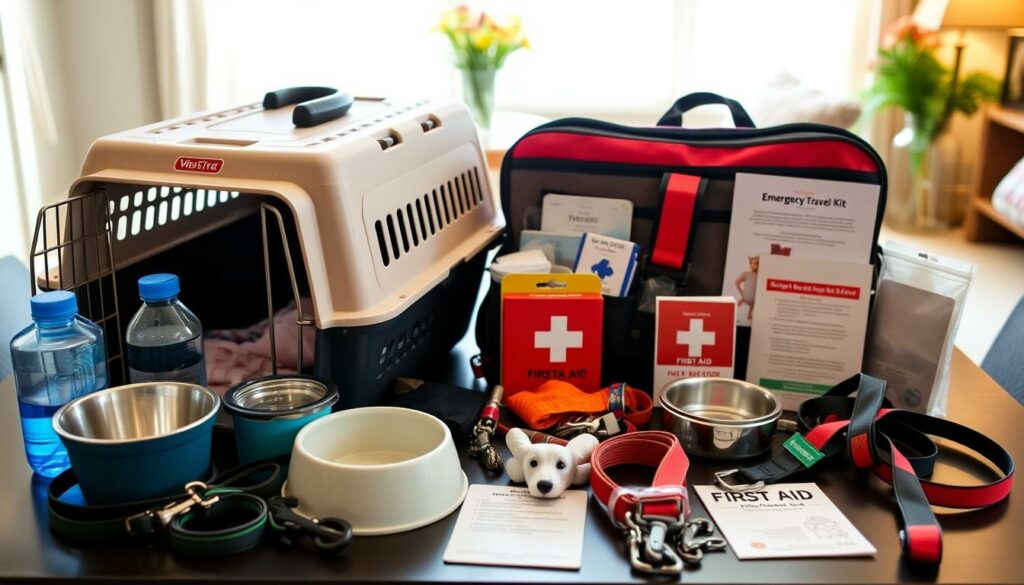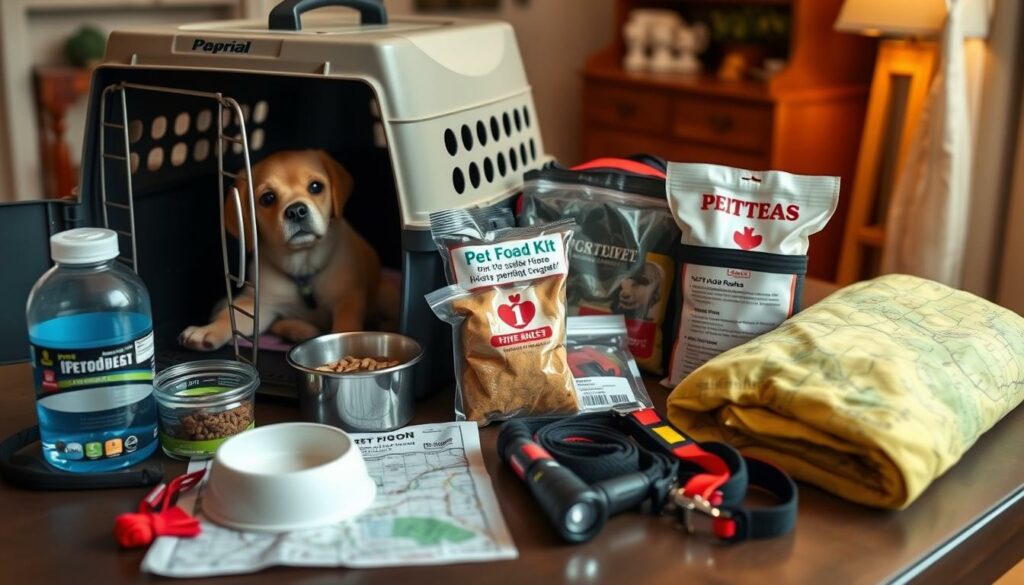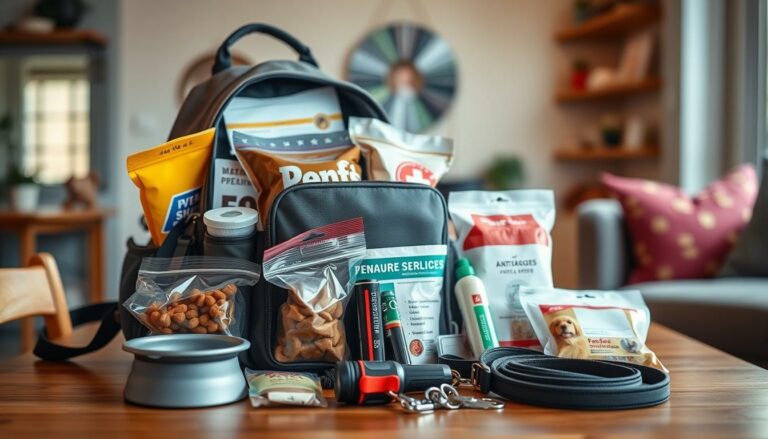When disaster hits, having a plan for your pets is key. They count on us for their safety. Making sure they’re included in disaster plans is vital. With the right steps, you can keep your pets safe during emergencies.
Creating a plan means more than just packing a bag. It’s about knowing what your pet needs and being ready for different situations. Since many shelters and hotels don’t allow pets, having a backup plan is crucial.
Begin by making two emergency kits for your pets: one for staying put and another for leaving quickly. Make sure these kits have food, water, medicines, leashes, collars, and updated ID tags. Also, keep your pet’s vaccination records handy and up-to-date.
Key Takeaways
- Create two pet emergency kits: one for home, one for evacuation
- Include several days’ supply of food, water, and medications
- Keep vaccination records and ID information current
- Identify pet-friendly shelters and accommodations in advance
- Practice evacuation drills with your pets
- Stay informed about local emergency alerts and weather conditions
- Bring pets indoors at the first sign of danger
Understanding the Importance of Pet Emergency Planning
Pet emergency planning is key to keeping your pets safe in disasters. Many pet owners forget this important step, leaving their pets at risk. A good plan can save lives when disaster hits.
Did you know, many shelters and hotels don’t accept pets? This shows why planning ahead is crucial. By being prepared, you lower the chance of your pets getting lost or hurt in emergencies.
Experts suggest making two emergency kits for your pets. One for staying put and another for leaving your home. These kits should have food, water, meds, and comfort items to keep your pets safe and calm.
“Having a picture of you and your pet together in the emergency kit helps in identifying ownership if separated.”
Here’s what you should put in your pet’s emergency kit:
| Category | Items | Quantity |
|---|---|---|
| Food and Water | Dry/Canned Food, Bottled Water | 5-day supply |
| Medical | Medications, First Aid Kit, Vaccination Records | 2-week supply |
| Identification | ID Tags, Microchip Information, Recent Photos | 1 set each |
| Comfort | Familiar Toys, Treats, Bedding | 2-3 items |
Getting ready for disasters with pets is more than just packing a kit. It means staying updated with emergency alerts, having your pets’ IDs ready, and planning for their safe move. These steps help ensure your pets are well cared for in any situation.
Creating a Pet-Inclusive Family Emergency Plan
Every pet owner needs a pet evacuation plan. Since 90% of public shelters don’t take pets, being ready is key. First, find pet-friendly places to go like hotels or boarding facilities away from your area. Keep a list of these spots with their contact info.
Developing a Pet Buddy System
A pet buddy system can really help in emergencies. Share pet details, house keys, and evacuation plans with trusted neighbors or friends. This way, your pets will be safe if you’re not there during a disaster. Make sure your buddy knows your pet’s habits and any special needs.
Ensuring Pet Identification and Microchipping
Having your pet identified is key to finding them if you get separated. Microchipping is a top choice. Keep your pet’s microchip info current in databases like PetLink. Also, put multiple current phone numbers on your pet’s collar tag.
- One-week supply of food and water
- Bowls and litter box
- Medications and medical records
- First aid kit
- Comfort items
- Carriers or crates
| Item | Dogs | Cats |
|---|---|---|
| Food Supply | 1 week | 1 week |
| Water Supply | 1 week | 1 week |
| Medication Supply | 2 weeks | 2 weeks |
| Specific Needs | Leash, crate | Litter box, carrier |
By taking these steps, you’ll have a solid emergency plan that keeps your whole family safe, including your pets.
Building an Emergency Kit for Your Pets
Creating a pet emergency kit is key for disaster readiness. It makes sure your pets have what they need in emergencies.
Essential Food and Water Supplies
Put in 7-10 days’ food for each pet, either canned or dry. Have bottled water ready, enough for a week for each person and pet. Make sure to check and replace food every two months to keep it fresh. And don’t forget bowls for feeding and watering.
Medications and Medical Records
Have two weeks’ worth of your pet’s meds ready. Keep medical records in a waterproof bag. Also, include your vet’s contact info for emergencies.
First Aid Kit for Pets
A first aid kit just for pets is a must. Include gauze, bandages, and safe antiseptic. And, have a pet first aid book for minor injuries.
Comfort Items and Familiar Belongings
Include comfort items to ease stress. Add your pet’s favorite toy, blanket, or bed. For cats, remember litter and a portable litter box. And, don’t forget leashes, harnesses, and carriers for pets.
Always update your pet’s emergency kit. Practice evacuation drills with your pets to help them get used to it. Being prepared means your pets will be safe and comfortable in tough times.
Preparing Pets for Safe Travel During Emergencies
Pet travel safety is key during emergencies. Begin by getting your pets used to their carriers or crates. Put these in places they often go, using treats to make them feel good about it. Add their familiar bedding to make the carrier a cozy spot.

Do practice runs with your pets to help them get used to moving in an emergency. This is crucial because many pets get lost during disasters and finding them again is hard. Microchipping is the best way to make sure you’ll find your lost pet.
Have your pet’s carrier ready to go at a moment’s notice for emergency pet transportation. Check your evacuation plan for places that accept pets. Remember, emergencies can happen when your pet is alone at home, so planning is key.
“Life is unpredictable; being prepared can make all the difference in keeping your pets safe during emergencies.”
Your pet emergency kit should include:
- Two weeks’ worth of food and water
- Medications and medical records
- Sanitation supplies
- Leashes and harnesses
- Microchip information
By following these steps, you’ll be ready to keep your pets safe in unexpected situations, like wildfires or flash floods. Remember, good planning is crucial for the safety of your furry family.
Special Considerations for Large Animals and Livestock
Livestock emergency planning is key for farm owners in the United States. With almost 2 million farms, many face big challenges during disasters. Planning for farm animal evacuation is crucial for their safety.
Evacuation Planning for Horses and Farm Animals
It’s vital to have a good plan for moving horses and livestock. Map out safe routes, both main and backup ones. Make sure you have the right vehicles and trailers ready.
If you can’t evacuate, think about moving animals to a strong barn or letting them go in a safe spot.
Identification and Transportation for Large Animals
It’s important to identify large animals during emergencies. Use tags, microchips, or brands for easy identification. Keep detailed records of each animal’s info.
For moving animals, get help from skilled handlers. They can assist with loading and keeping animals safe during transport.
- Create an emergency kit for your animals with food, water, and medical supplies
- Know when to evacuate or stay put based on the disaster
- Build a strong shelter for your animals in emergencies
- Get help from local officials like the National Animal Health Emergency Response Corps
By following these steps, farm owners can better plan for emergencies. This helps increase the chances of a successful evacuation for farm animals.
Pet Emergency Preparedness: Essential Steps for Disaster Readiness
Getting your pets ready for disasters is key to their safety. By acting early, you can greatly improve their chances of staying safe when emergencies happen.

First, make a disaster kit for your pets. It should have food, water, any needed medicines, and things that make them feel secure. Make sure it’s easy to grab if you need to leave quickly.
But it’s not just about the supplies. Make sure your pets’ shots are current and know where they can stay if you can’t. It’s also crucial to have someone who knows your pets well to look after them if you’re not there.
“Prepare today for peace of mind tomorrow. Your pets rely on you to keep them safe.”
Practice moving your pets out of the house to make it easier when it’s a real emergency. This helps lower stress for you and your pets when every second counts.
| Preparedness Item | Importance | Action Step |
|---|---|---|
| Pet Disaster Kit | High | Assemble and store in an accessible location |
| Vaccination Records | Critical | Keep updated and include in disaster kit |
| Pet-Friendly Accommodations List | Medium | Research and compile contact information |
| Backup Caretaker | High | Arrange and share pet care instructions |
| Evacuation Drills | Medium | Practice regularly with pets |
Your pets depend on you for their safety. By getting them ready for disasters, you’re making sure they’ll be okay with your family in emergencies.
Staying Informed: Utilizing Emergency Alert Systems for Pet Owners
Pet owners must stay alert during emergencies. Pet emergency alerts are key to keeping your pets safe. It’s vital to know the rules of pet-friendly shelters in your area.
In Pinellas County, many shelters take in cats and dogs. Owners must stay with their pets and look after them. No need to register in advance. Service animals are also welcome at any shelter.
Knowing disaster info for pet owners is crucial. Make an emergency kit with two weeks of pet food and water. Make sure your pets are microchipped and vaccinated. Plan for boarding or find someone to watch your pets if needed.
| Emergency Preparedness Item | Recommendation |
|---|---|
| Pet food and water supply | Minimum 2 weeks |
| Pet identification | Microchip and up-to-date vaccinations |
| Shelter registration | Not required in advance |
| Light source during power outage | Flashlights preferred over candles |
During hurricanes, keep pets in carriers or crates. Stay inside on the lowest level, in a small room with few windows. Use flashlights, not candles, when the power goes out. Always take your pets with you when evacuating – they’re part of the family!
“The No. 1 instruction for pet owners during evacuations is to bring pets with them.”
Ask your local emergency management agency about pet-friendly shelters. Have a list of places that accept pets for quick evacuations. Listen to the radio or TV for weather updates and follow official orders to keep you and your pets safe.
Evacuation Procedures: When and How to Leave with Your Pets
When disaster hits, it’s vital to follow pet evacuation steps to keep your pets safe. Acting early helps make leaving easier and lowers stress for you and your pets. Start moving quickly when warnings come out, even before it’s mandatory.
Early Evacuation Strategies
First, find places that are safe for pets ahead of time. Call RedRover at (800) 440-3277 for help with emergency shelters in the U.S. and Canada. Pack enough food, water, and any needed medicine for a week. Also, bring recent photos of your pets to help identify them.
Transportation Safety for Pets
Keeping pets safe while moving is crucial. Use strong carriers or leashes to stop them from running off. After the crisis, keep pets on leashes or in carriers. This is because their familiar smells and sights may have changed. Watch out for dangers like snakes or downed power lines that could hurt pets and people.
Your pets might act differently after a disaster. Keep an eye on them and let them out only in safe places. If they seem very stressed or sick, see a vet. By using these steps for evacuating pets and keeping them safe, you’ll be ready to protect your whole family, including your pets, in emergencies.
Source Links
- https://www.ready.gov/sites/default/files/2023-06/ready.gov_prepare-pets-for-disasters.pdf
- https://www.fema.gov/fact-sheet/are-you-petpared-disasters
- https://www.ready.gov/pets
- https://www.humanesociety.org/resources/pet-disaster-preparedness
- https://redrover.org/pet-disaster-preparedness/
- https://www.petlink.net/blog/including-pet-emergency-plans-disaster-preparedness-month/
- https://www.muni.org/departments/health/admin/animal_control/pages/disaster.aspx
- https://bestfriends.org/pet-care-resources/pet-emergency-kit-checklist-and-plan
- https://www.aspca.org/pet-care/general-pet-care/disaster-preparedness
- https://www.onstar.com/stories/protect-pets-during-disaster
- https://allanimalveterinaryservices.com/pet-disaster-preparedness-keep-your-pets-safe-in-emergencies/
- https://firstrespondersfoundation.org/emergency-response-and-animal-safety-tips-for-pet-owners/
- https://www.fema.gov/blog/your-farm-ready-4-livestock-preparedness-tips
- https://www.prep4agthreats.org/All-Hazard-Preparedness/livestock-and-pet-emergency-preparedness-plan
- https://www.scemd.org/prepare/your-emergency-plan/pet-planning/
- https://pinellas.gov/preparing-pets-for-emergencies/
- https://www.fda.gov/animal-veterinary/animal-health-literacy/taking-care-your-pets-during-hurricanes-and-floods
- https://www.cdc.gov/healthy-pets/emergency-preparedness/index.html
- https://www.fda.gov/consumers/consumer-updates/plan-prepare-and-protect-your-pet-during-and-after-emergency

